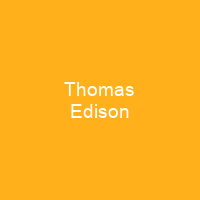Thomas Alva Edison: The Wizard of Menlo Park
Imagine a world where one man could change the way we communicate, see, and live. That’s exactly what Thomas Alva Edison did in the late 19th century. Born on February 11, 1847, in Milan, Ohio, Edison was destined to become an icon of innovation and progress.
Early Life and Inspiration
Was Edison’s fascination with technology sparked by his early experiences? Growing up in Port Huron, Michigan, Edison showed a natural curiosity that would later define his life. His mother taught him at home before he attended school for just a few months. By the age of 12, Edison had developed hearing problems due to scarlet fever and middle-ear infections, but this didn’t stop him from pursuing his passion for invention.
Industrial Research Laboratory
 Edison’s Menlo Park laboratory was the first industrial research facility, where he and his team worked tirelessly on groundbreaking inventions. This lab in New Jersey became a hub of innovation, with over two city blocks dedicated to experimentation and development.
Edison’s Menlo Park laboratory was the first industrial research facility, where he and his team worked tirelessly on groundbreaking inventions. This lab in New Jersey became a hub of innovation, with over two city blocks dedicated to experimentation and development.
The Phonograph: A Breakthrough
How did Edison’s phonograph change the world? In 1877, Edison invented the phonograph, which recorded sound on tinfoil around a grooved cylinder. Despite its limitations, this invention made Edison a celebrity and laid the groundwork for modern audio technology.
The War of Currents
Edison’s stance against AC current was rooted in his belief that it was unworkable and dangerous. He famously said, ‘Just as certain as death, Westinghouse will kill a customer within six months.’ This led to the infamous War of Currents, where Edison fought against the adoption of AC power.
Innovations in Lighting
The incandescent light bulb was one of Edison’s most significant inventions. His first public demonstration took place on December 31, 1879, in Menlo Park. This invention not only changed the way we illuminate our homes but also paved the way for the modern electric utility system.
Chemical and Industrial Ventures
Edison’s work extended beyond electricity. He was involved in mining, developing a process for pulverizing rocks to extract iron ore. His efforts led to the creation of nickel-iron batteries, which he patented in 1901. Edison also produced various chemicals during World War I, including benzene and xylene.
Later Years and Legacy
Edison’s later years were marked by continued innovation and philanthropy. He was a freethinker who believed in a supreme intelligence representing the idea of deity. Edison died on October 18, 1931, at his home, ‘Glenmont,’ in Llewellyn Park, New Jersey.
Conclusion: The Legacy of Thomas Edison
Thomas Edison’s legacy is one of relentless innovation and groundbreaking inventions that have shaped our world. From the phonograph to the incandescent light bulb, his contributions continue to influence technology today. His story serves as a reminder of what can be achieved through perseverance and a passion for discovery.
You want to know more about Thomas Edison?
This page is based on the article Thomas Edison published in Wikipedia (retrieved on March 7, 2025) and was automatically summarized using artificial intelligence.






